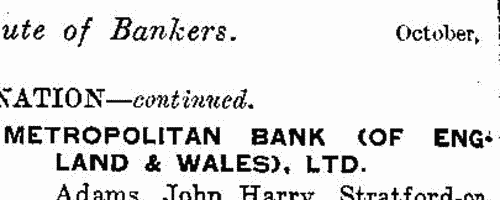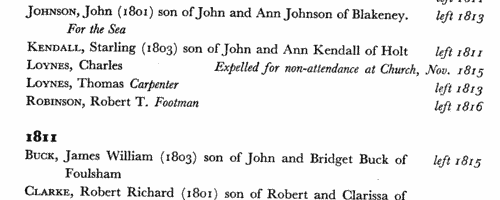Learner Surname Ancestry ResultsOur indexes 1000-1999 include entries for the spelling 'learner'. In the period you have requested, we have the following 27 records (displaying 21 to 27): Single Surname Subscription | | | Buying all 27 results of this search individually would cost £156.00. But you can have free access to all 27 records for a year, to view, to save and print, for £100. Save £56.00. More... |
These sample scans are from the original record. You will get scans of the full pages or articles where the surname you searched for has been found. Your web browser may prevent the sample windows from opening; in this case please change your browser settings to allow pop-up windows from this site. London Preachers and Mission Hall Keepers (1886)
'The Census of Morning and Evening Attendance in the Churches and Chapels of London, Sunday, October 24th, 1886' was compiled by The British Weekly, employing several thousand persons, and extended to every denomination and sect, giving the number of attendances in the morning (M.) and in the evening (E.), and the name of the incumbent or priest conducting the service. 1500 churches and chapels were found at worship in the city on that day: 'the enumeration was made by actual counting, official estimate being in no case accepted when unconfirmed'. The census covered Kensington, Fulham, Chelsea, St George Hanover Square, Westminster, Marylebone, Hampstead, St Pancras, Islington, Hackney, St Giles, Strand, Holborn, London City, Shoreditch, Bethnal Green, Whitechapel, St George-in-the-East, Stepney, Mile-end and Poplar in Middlesex; St Saviour Southwark, St Olave Southwark, Lambeth, Wandsworth and Camberwell in Surrey; and Greenwich, Lewisham, and Woolwich in Kent. These 29 registration districts comprised a population of about 4,100,000. About half a million attended morning service on that day; 269,799 Anglicans, 142,425 Congregationalists, and relatively smaller numbers for other denominations. In addition, a parallel survey was made of the attendance at the London mission halls and similar minor places of worship: these attracted 203,504 to the three services of the day (morning, afternoon and evening) of whom only 26,096 were specifically Anglican, 49,874 being undenominational.
LEARNER. Cost: £8.00.  | Sample scan, click to enlarge

| Residents of Surrey
(1895)
Kelly's Directory of Surrey includes this alphabetical Court Directory, listing private residents in the county. In fact, this listing is a little more comprehensive than the main directory, in that it includes residents of some London suburbs that, although in the county of Surrey, are not included in the Surrey directory. Residents are listed surname first, then christian name or initials, and postal address.LEARNER. Cost: £4.00.  | Sample scan, click to enlarge

|  British artillerymen fighting in South Africa
(1899-1902) British artillerymen fighting in South Africa
(1899-1902)
The Queen Victoria's South Africa Medal was awarded (after her death, in the event) to all who had served honourably in the various campaigns in the Boer War. Returns were made from each unit, and consolidated into nominal roll, of which this is the one for the Royal Artillery. Confusingly, the ledgers used had originally been printed for a register of men transferred (or re-transferred after mobilization) to 1st Class Army Reserve. All the original column headings were therefore struck through, and the roll was prepared with this information: Date of Issue; Regimental Number; Rank; Name; Unit; Medal (a 1 indicating that a medal was awarded); [number of] Clasps; the reference to the source in the original returns, usually starting with AG for papers in the hands of the Adjutant-General, and 68/Art/ for the Royal Artillery records. The final column, normally left blank, was occasionally used for explanatory remarks.LEARNER. Cost: £8.00.  | Sample scan, click to enlarge

| Banking students
(1908)
The annual examinations of the Institute of Banking were held 13-15 April 1908. This list of students passing the Final and Preliminary levels was printed in the Journal of the Institute of the following October. Each student's name is given in full, with the name of their bank; and, for the Preliminary level, their home address.LEARNER. Cost: £6.00.  | Sample scan, click to enlarge

| Naturalizations
(1919)
The Home Office issued monthly lists of aliens to whom Certificates of Naturalization or Readmission to British Nationality had been granted by the Secretary of State and whose oaths of allegiance had been registered in the Home Office. These notices, from January to December 1919, refer to naturalizations from December 1918 to November 1919. The lists give full name, surname first; country of origin; date of taking the oath of allegiance; place of residence; and occupation. An dagger indicates re-admission to British nationality.LEARNER. Cost: £6.00.  | Sample scan, click to enlarge

| Naturalizations
(1920)
The Home Office issued monthly lists of aliens to whom Certificates of Naturalization or Readmission to British Nationality had been granted by the Secretary of State and whose oaths of allegiance had been registered in the Home Office. These notices, from January to December 1920, refer to naturalizations from December 1919 to November 1920. The lists give full name, surname first; country of origin; date of taking the oath of allegiance; place of residence; and occupation. A dagger indicates re-admission to British nationality.LEARNER. Cost: £6.00.  | Sample scan, click to enlarge

| Boys entering Gresham's School
(1947)
The Sir John Gresham Grammar School at Holt in Norfolk was founded by sir John, who bought the manor house there in 1546 to convert it into a school, and building work had started by 1555. To celebrate the quatercentenary in 1955, a history of the school written by the Reverend C. L. S. Linnell was published, together with an Alumni Greshamienses, a register of boys entering the school from 1562 to 1954, compiled by A. B. Douglas. The materials to hand for the register for the early years were slight; the first coherent lists of boys survive only from 1729, and then are fitful, with little detail, and largely missing from 1784 to 1803; however, from 1810 onwards the names of boys' parents are usually recorded. The register is arranged chronologically by year (and from 1900 by term - L, Lent; M, Michaelmas; S, Summer), and then alphabetically by surname (in capitals) and christian name(s). Where known, year of birth is then given (in brackets), names, addresses and occupations of parents. From 1900 onwards there are italic abbreviations for sporting achievements at school (h, hockey colours; VIII, shooting colours; S, first-class swimmer; XI, cricket colours; XV, football colours), and p for house prefect and P for school prefect; then (in italics) information about the boy's adult life, and his address (where living) at the time of publication. Finally, on the right hand side of the page, in italics, is given the year of his leaving the school. Most detail is absent before 1810; and, of course, for the boys still at school in 1955, or only recently left, there are no details of future career; nor are there the usual details about their parentage. From 1898 onwards day boys are noted with an italic D (N means Newquay dayboy); and from 1900 onwards the school houses are shown (B, Bengal Lodge; F, Farfield; H, School House or Howson's; K, Kenwyn; O, Old School House; W, Woodlands); and, for the junior school, c, Crossways; k, Kenwyn; o, Old School House).LEARNER. Cost: £4.00.  | Sample scan, click to enlarge

|
Research your ancestry, family history, genealogy and one-name study by direct access to original records and archives indexed by surname.
|










